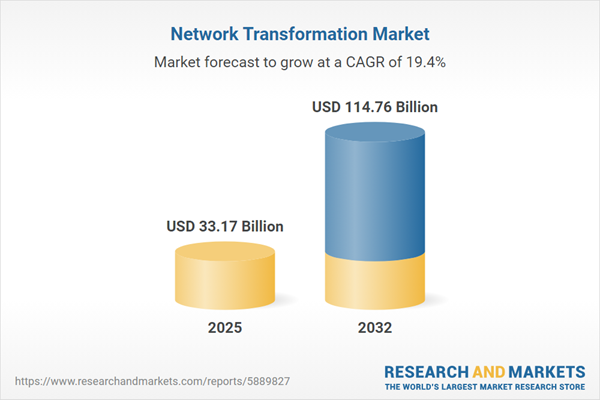Speak directly to the analyst to clarify any post sales queries you may have.
Network transformation is redefining enterprise connectivity, providing a secure and agile digital backbone as organizations adapt to evolving technology, compliance, and business imperatives. Modern approaches deliver the control and resilience that senior decision-makers require to align IT investments with strategic growth and risk management.
Market Snapshot: Network Transformation Market Outlook
The global network transformation market is undergoing strong expansion. Currently, the market is valued at USD 27.77 billion in 2024 and projected to rise to USD 33.17 billion in the following year. Sustained momentum is anticipated through 2032, supported by a robust 19.40% compound annual growth rate. This trajectory is driven by enterprise demand for adaptable, scalable connectivity. Rapid cloud migration, expanding edge computing, and complex Internet of Things (IoT) requirements are accelerating adoption. Regulatory pressures and the need to handle multifaceted data flows are further prompting organizations to upgrade network solutions. For companies facing digital disruption and diverse regulatory landscapes, investment in modern network architectures is proving essential for operational stability and compliance.
Scope & Segmentation: Network Transformation Market
- Component: Encompasses advanced network hardware such as routers and switches, operational efficiency services, and software for analytics, orchestration, and security controls, ensuring integrated network management.
- Solution Type: Includes analytic platforms, virtualization, SD-WAN, and integrated systems focused on automated compliance and streamlined process management, helping to modernize legacy network assets.
- Deployment Model: Features cloud, on-premises, and hybrid solutions designed to match varying regulatory requirements, each supporting distinct business goals and technology strategies.
- Organization Size: Addresses the differing needs of large enterprises as well as small and midsize businesses, providing scalable infrastructure that supports optimal resource allocation and operational performance.
- Verticals: Serves industries such as banking, insurance, IT, telecom, healthcare, manufacturing, government, and retail, recognizing each sector’s unique data protection and compliance challenges.
- Regional Coverage: Covers the Americas, Europe, Middle East & Africa, and Asia-Pacific, facilitating market penetration strategies that reflect local infrastructure readiness, adoption rates, and regulatory frameworks.
- Leading Enterprises: Engages major market providers, including Cisco Systems, Huawei Technologies, Nokia, Ericsson, and Juniper Networks, contributing expertise on both deployment and global collaboration.
Key Takeaways for Senior Decision-Makers
- Software-defined networking allows organizations to achieve consistent service delivery and strengthens adaptability to technology changes.
- Automation powered by virtualization and artificial intelligence is helping organizations increase operational efficiency, particularly across distributed or complex network infrastructures.
- Zero-trust methodologies and network segmentation support compliance efforts and help safeguard sensitive data against emerging cyber risks.
- Industry-specific network solutions balance the need for high performance with stringent privacy and regulatory demands in regulated sectors like healthcare and finance.
- Regional infrastructure maturity, local legal standards, and operational environments dictate network transformation strategies and their impact on business outcomes.
- Partnerships with experienced technology providers are instrumental in accelerating solution integration and addressing organizational skill gaps.
Tariff Impact: Network Infrastructure and U.S. Supply Chain Resilience
Recent U.S. hardware tariffs are prompting businesses to reassess supplier relationships and procurement models. This policy shift is accelerating the adoption of software-centric transformation, reducing exposure to hardware-related disruptions. As these trends ripple through supply chains, organizations are finding greater operational stability and improved management of modernization initiatives in unpredictable environments.
Methodology & Data Sources
This analysis is based on insights from CIOs, network architects, and market analysts, incorporating technology adoption research, regulatory developments, and scenario-based planning. The findings support senior leadership decision-making by offering actionable, targeted intelligence for network strategy and investment.
Why This Report Matters
- Guides executives as they adapt network transformation strategies to the shifting technology, security, and compliance needs that shape modern enterprises.
- Clarifies key segments and solution pathways, assisting in the identification of growth opportunities and innovations in compliance.
- Enables decision-makers to optimize risk management and network efficiency as enterprise connectivity requirements become more complex.
Conclusion
Network transformation stands at the center of secure, adaptable business platforms. This report supports executive teams in anticipating shifts in business and regulatory priorities while guiding technology modernization efforts with confidence.
Additional Product Information:
- Purchase of this report includes 1 year online access with quarterly updates.
- This report can be updated on request. Please contact our Customer Experience team using the Ask a Question widget on our website.
Table of Contents
3. Executive Summary
4. Market Overview
7. Cumulative Impact of Artificial Intelligence 2025
Companies Mentioned
The companies profiled in this Network Transformation market report include:- Cisco Systems, Inc.
- Huawei Technologies Co., Ltd.
- Nokia Corporation
- Telefonaktiebolaget LM Ericsson
- Juniper Networks, Inc.
- Hewlett Packard Enterprise Company
- Dell Technologies Inc.
- VMware, Inc.
- Arista Networks, Inc.
- Ciena Corporation
Table Information
| Report Attribute | Details |
|---|---|
| No. of Pages | 199 |
| Published | November 2025 |
| Forecast Period | 2025 - 2032 |
| Estimated Market Value ( USD | $ 33.17 Billion |
| Forecasted Market Value ( USD | $ 114.76 Billion |
| Compound Annual Growth Rate | 19.4% |
| Regions Covered | Global |
| No. of Companies Mentioned | 11 |









